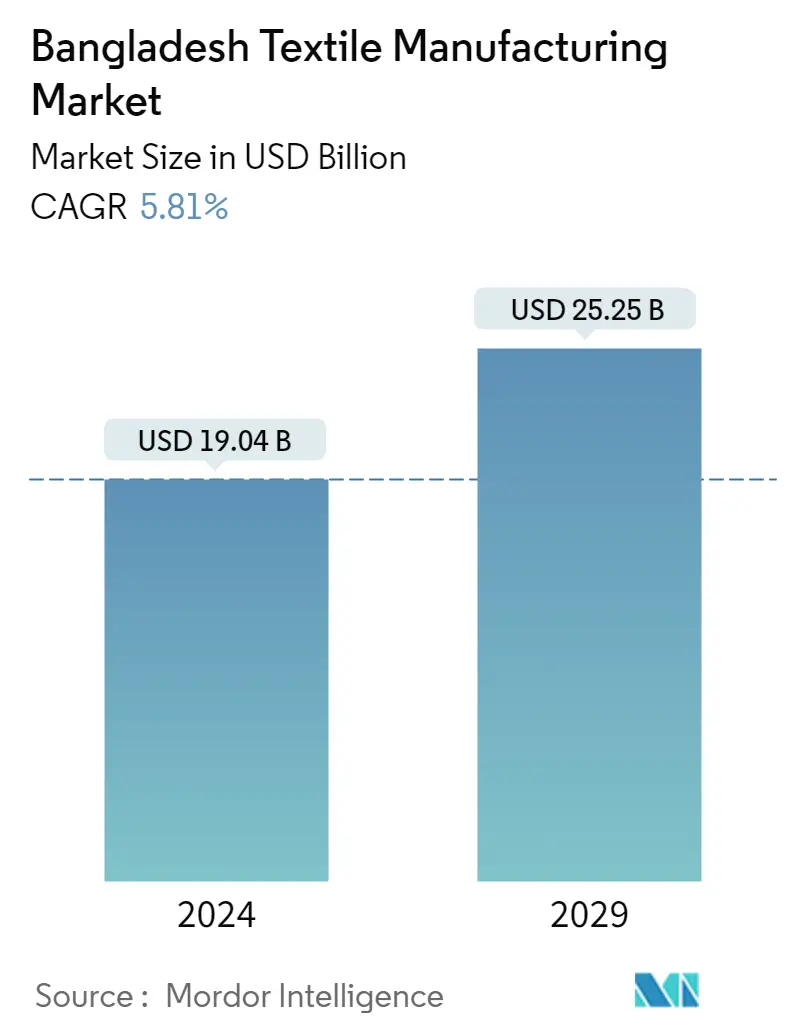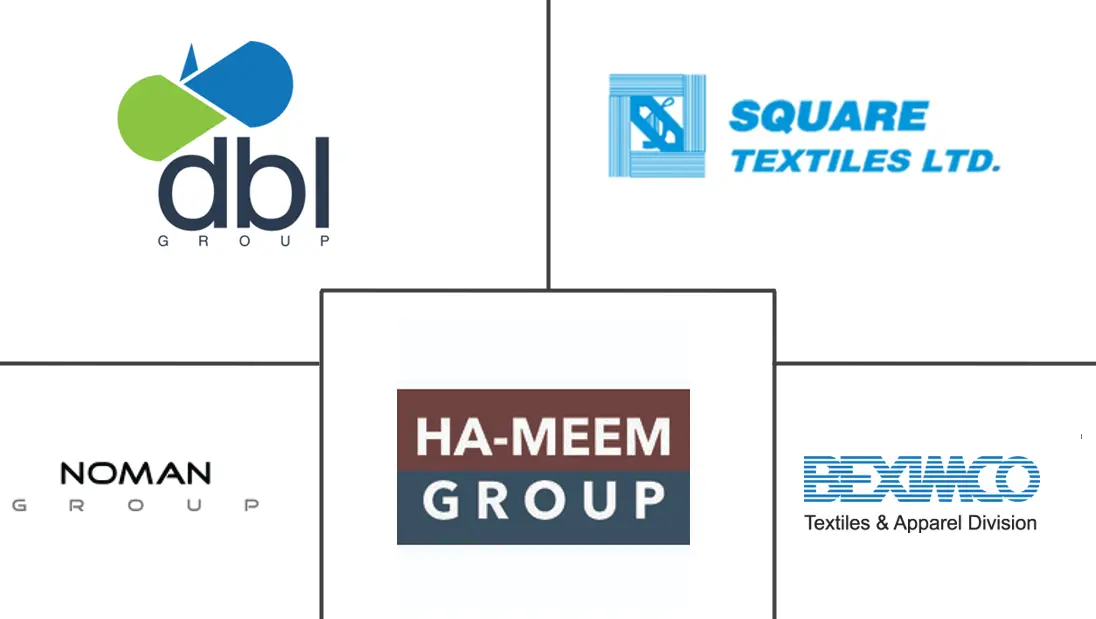Market Size of Bangladesh Textile Manufacturing Industry

| Study Period | 2019 - 2029 |
| Base Year For Estimation | 2023 |
| Market Size (2024) | USD 19.04 Billion |
| Market Size (2029) | USD 25.25 Billion |
| CAGR (2024 - 2029) | 5.81 % |
| Market Concentration | Low |
Major Players
*Disclaimer: Major Players sorted in no particular order |
Bangladesh Textile Market Analysis
The Bangladesh Textile Manufacturing Market size is estimated at USD 19.04 billion in 2024, and is expected to reach USD 25.25 billion by 2029, growing at a CAGR of 5.81% during the forecast period (2024-2029).
- COVID-19 had a severe impact on the textile manufacturing industry. In the first half of 2020, the industry faced a shortage of labor supply and logistics difficulty due to the country's lockdown. COVID-19 also impacted the sales of textiles due to the closure of supermarkets and other physical retail stores as per the government's strict restrictions.
- However, the COVID-19 crisis accelerated e-commerce sales in the market studied. Still, in FY 2020-21, Bangladesh's ready-made garment (RMG) exports grew by 12.55% to USD 31.46 billion (out of USD 38.76 billion in total exports) as demand in major markets in Europe and North America began to recover from the COVID-19 pandemic.
- The textile sector contributes more than 13% of Bangladesh's GDP. Over 84% of the export earnings come from textiles and textile-related products. The country invested around USD 15 billion in the primary textile sector. The Primary Textile Sector (PTS) meets approximately 85-90% of the yarn demand for knit RMG and 35-40% for woven RMG.
- The demand for local fabric and yarn for handlooms is also met by the Primary Textile Sector (PTS). The Bangladesh Textile Mills Association (BTMA) is the national trade organization representing yarn and fabric manufacturers and textile product processors in the country in the private sector. The BTMA has 510 yarn manufacturing mills, 901 fabric manufacturing mills, and 317 dyeing, printing, and finishing mills as members, totaling 1,728 member mills.
- According to statistics from the Export Promotion Bureau of the Government of Bangladesh, RMG exports were up by 13.4% from July to September 2022, at USD 10.27 billion from USD 9.06 billion a year earlier. The figure beat Bangladesh's export target of USD 10.02 billion for the quarter. Knitwear exports were up by 9.4% to reach USD 5.65 billion from USD 5.16 billion, beating a target of USD 5.5 billion. Exports of woven garments jumped by nearly 19% to reach USD 4.62 billion, up from USD 3.9 billion a year earlier. This trend greatly benefited the textile manufacturing sector in the country. However, Bangladesh RMG exporters are facing hurdles with declining shipments to and payments from Russia due to the ongoing Russia-Ukraine war.
- Many garment suppliers are not receiving export receipts as several Russian banks have been banned from using SWIFT, the global payments messaging network. Around 150 apparel exporters from Bangladesh have been keenly tapping the emerging Russian market. Bangladesh-Russia trade is valued at more than USD 1 billion and is growing. Many exporters stated that their goods are stuck at Chattogram port because shipping lines are not ready to take them on board. Others have reported that their documents have been sent back from Hungary due to the SWIFT ban. These factors are negatively affecting the market.
Bangladesh Textile Industry Segmentation
The textile industry is mainly involved in processing fiber into yarn and yarn into fabric. The report aims to provide a detailed analysis of the textile manufacturing market. The report focuses on market dynamics, emerging trends in the segments and regional markets, and insights on various product and application types. It also analyzes the key players and the competitive landscape in the textile manufacturing market.
The Bangladesh textile manufacturing market is segmented by application type (clothing, industrial, and household applications), material (cotton, jute, silk, synthetics, and wool), and process (woven and non-woven). The report offers market sizes and forecasts for all the above segments in value (USD billion).
| By Application | |
| Clothing Application | |
| Industrial Application | |
| Household Application |
| By Material | |
| Cotton | |
| Jute | |
| Silk | |
| Wool | |
| Synthetic | |
| Other Materials |
| By Process | |
| Woven | |
| Non-woven |
Bangladesh Textile Manufacturing Market Size Summary
The Bangladesh textile manufacturing industry is a pivotal sector in the country's economy, significantly contributing to its GDP and export earnings. The industry is characterized by a robust network of over 4,500 factories, primarily concentrated around Dhaka, making Bangladesh the second-largest clothing exporter globally, trailing only China. The sector's growth trajectory is supported by the Primary Textile Sector, which meets a substantial portion of the yarn and fabric demand for ready-made garments (RMG). Despite challenges posed by the COVID-19 pandemic, such as labor shortages and logistical issues, the industry has shown resilience, with a notable recovery in RMG exports to major markets in Europe and North America. The sector's competitive landscape is marked by the presence of numerous regional and global players, with key companies like Ha-Meem Group, Noman Group, and Beximco Textile Division Limited leading the charge through innovations and strategic expansions.
The market is poised for continued growth, driven by increasing demand for natural fibers like cotton, silk, and jute, which are integral to various applications, including automotive interiors and apparel. The Bangladeshi textile industry is also adapting to emerging markets, with significant export opportunities in countries like China, Brazil, Japan, and Australia. However, geopolitical challenges, such as the Russia-Ukraine conflict, have posed hurdles, affecting trade dynamics and payment processes. The industry remains focused on sustainability and efficiency, as evidenced by initiatives like the Asian Development Bank's support for energy-efficient machinery installations. Collaborative efforts, such as the Memorandum of Understanding between the American Apparel and Footwear Association and the Bangladesh Garment Manufacturers and Exporters Association, aim to enhance trade access and sustainability practices, further solidifying the industry's role as a cornerstone of Bangladesh's economic landscape.
Bangladesh Textile Manufacturing Market Size - Table of Contents
-
1. MARKET DYNAMICS AND INSIGHTS
-
1.1 Market Dynamics
-
1.1.1 Market Drivers
-
1.1.2 Market Restraints
-
1.1.3 Market Opportunities
-
-
1.2 Value Chain/Supply Chain Analysis
-
1.3 Porter's Five Forces Analysis
-
1.3.1 Threat of New Entrants
-
1.3.2 Bargaining Power of Buyers/Consumers
-
1.3.3 Bargaining Power of Suppliers
-
1.3.4 Threat of Substitute Products
-
1.3.5 Intensity of Competitive Rivalry
-
-
-
2. MARKET SEGMENTATION
-
2.1 By Application
-
2.1.1 Clothing Application
-
2.1.2 Industrial Application
-
2.1.3 Household Application
-
-
2.2 By Material
-
2.2.1 Cotton
-
2.2.2 Jute
-
2.2.3 Silk
-
2.2.4 Wool
-
2.2.5 Synthetic
-
2.2.6 Other Materials
-
-
2.3 By Process
-
2.3.1 Woven
-
2.3.2 Non-woven
-
-
Bangladesh Textile Manufacturing Market Size FAQs
How big is the Bangladesh Textile Manufacturing Market?
The Bangladesh Textile Manufacturing Market size is expected to reach USD 19.04 billion in 2024 and grow at a CAGR of 5.81% to reach USD 25.25 billion by 2029.
What is the current Bangladesh Textile Manufacturing Market size?
In 2024, the Bangladesh Textile Manufacturing Market size is expected to reach USD 19.04 billion.

